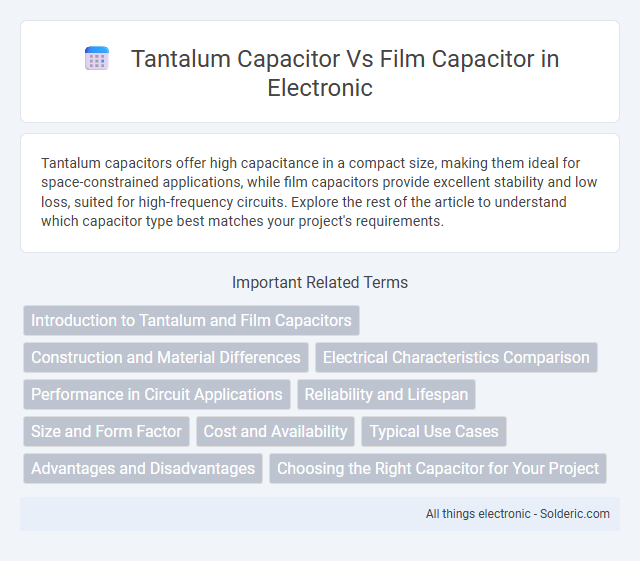Tantalum capacitors offer high capacitance in a compact size, making them ideal for space-constrained applications, while film capacitors provide excellent stability and low loss, suited for high-frequency circuits. Explore the rest of the article to understand which capacitor type best matches your project's requirements.
Comparison Table
| Feature | Tantalum Capacitor | Film Capacitor |
|---|---|---|
| Dielectric Material | Tantalum Pentoxide | Plastic Film (Polyester, Polypropylene, etc.) |
| Capacitance Range | 0.1 uF to 470 uF | 0.001 uF to 100 uF |
| Voltage Range | 6.3 V to 50 V | 50 V to 1000 V+ |
| Equivalent Series Resistance (ESR) | Low ESR, suitable for high-frequency applications | Very low ESR, excellent for precision and RF circuits |
| Leakage Current | Higher leakage current | Very low leakage current |
| Stability and Tolerance | Moderate stability, typical tolerance +-20% | High stability, tight tolerance +-1% to +-5% |
| Temperature Range | -55degC to +125degC | -55degC to +105degC or higher |
| Size and Volume | Compact, higher capacitance per volume | Larger size for same capacitance |
| Applications | Power supplies, decoupling, filtering | Audio, precision timing, high-voltage filtering |
| Cost | Moderate cost | Generally higher cost |
Introduction to Tantalum and Film Capacitors
Tantalum capacitors utilize a tantalum metal anode and solid electrolyte, offering high capacitance per volume and stable electrical performance, ideal for compact and high-reliability applications. Film capacitors employ thin plastic dielectric films, providing excellent insulation, low ESR (Equivalent Series Resistance), and superior frequency characteristics, making them suitable for precision filtering and audio applications. Both capacitor types serve distinct roles in electronic circuits, with tantalum capacitors excelling in miniaturization and film capacitors preferred for stability and low losses.
Construction and Material Differences
Tantalum capacitors feature a solid tantalum metal anode coated with a thin layer of tantalum pentoxide dielectric, combined with a conductive cathode, resulting in a compact and high-capacitance design. Film capacitors use plastic dielectric films such as polyester or polypropylene sandwiched between metal electrodes, providing excellent stability and low ESR through a multilayer construction. Your choice depends on whether you prioritize the high volumetric efficiency of tantalum or the superior tolerance and longevity offered by film capacitors.
Electrical Characteristics Comparison
Tantalum capacitors offer high capacitance per volume and stable electrical characteristics with low equivalent series resistance (ESR), making them ideal for filtering and decoupling in compact circuits. Film capacitors exhibit excellent insulation resistance, low dielectric absorption, and superior frequency stability, which enhances their performance in precision timing and audio applications. Understanding your circuit's specific electrical demands will help determine whether the low ESR and size advantages of tantalum or the high stability and reliability of film capacitors better suit your needs.
Performance in Circuit Applications
Tantalum capacitors exhibit high capacitance per volume and stable performance under varying temperatures, making them ideal for compact, high-reliability applications like power supply filtering and decoupling. Film capacitors offer superior insulation resistance, low dielectric absorption, and excellent frequency response, which enhances performance in signal processing and audio circuits. The choice between tantalum and film capacitors depends on circuit requirements for size, stability, frequency range, and reliability.
Reliability and Lifespan
Tantalum capacitors exhibit high reliability due to their stable dielectric oxide layer, ensuring consistent performance in demanding environments, with lifespans typically ranging from 1,000 to 5,000 hours at rated conditions. Film capacitors offer superior lifespan exceeding 100,000 hours thanks to their self-healing properties and robust polymer dielectrics, making them highly dependable for long-term applications. Both capacitor types provide dependable solutions, but film capacitors generally outperform tantalum capacitors in durability and operational longevity under normal use.
Size and Form Factor
Tantalum capacitors offer a smaller size and higher volumetric efficiency compared to film capacitors, making them ideal for compact electronic designs requiring high capacitance in limited space. Film capacitors typically have larger form factors due to their construction, which involves thicker dielectric layers and larger electrode surfaces, resulting in bulkier modules. Your choice between the two depends on the spatial constraints and performance requirements of your application.
Cost and Availability
Tantalum capacitors generally have higher costs due to their complex manufacturing processes and the use of rare materials such as tantalum metal. Film capacitors tend to be more cost-effective and widely available, benefiting from mass-production techniques and the use of common polymers like polyester and polypropylene. The availability of tantalum capacitors is often limited by supply chain constraints and ethical concerns over tantalum sourcing, whereas film capacitors face fewer supply risks and offer broader accessibility in various electronic applications.
Typical Use Cases
Tantalum capacitors are typically used in applications requiring stable capacitance and high volumetric efficiency, such as in power supply filtering, audio equipment, and space-constrained electronics. Film capacitors excel in high-frequency circuits, precision timing, and noise suppression due to their low dielectric loss and excellent stability. Your choice depends on whether you prioritize compact size and reliability (tantalum) or high-frequency performance and long-term stability (film).
Advantages and Disadvantages
Tantalum capacitors offer high capacitance per volume and excellent stability, making them ideal for compact electronic devices, but they have a limited surge current tolerance and are sensitive to voltage spikes. Film capacitors provide superior insulation resistance, low dissipation factor, and longer lifespan, which enhances reliability in high-frequency applications, though they tend to be larger and more expensive than tantalum types. Your choice depends on balancing size constraints, performance requirements, and budget considerations.
Choosing the Right Capacitor for Your Project
Tantalum capacitors offer high capacitance in a compact size, making them ideal for applications requiring stable performance under varying temperatures and voltages. Film capacitors provide excellent reliability, low ESR, and superior frequency response, suitable for high-precision and audio circuits. Understanding your project's voltage, capacitance, frequency, and size requirements helps you choose between tantalum and film capacitors effectively.
tantalum capacitor vs film capacitor Infographic

 solderic.com
solderic.com